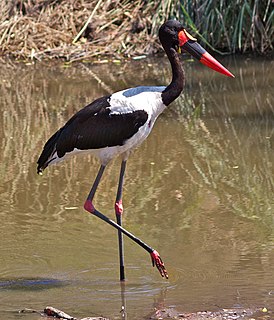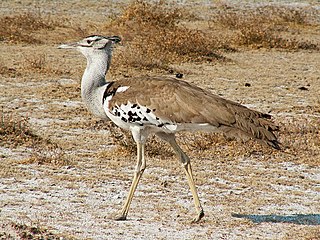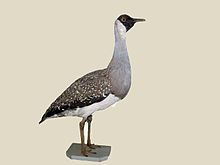
Bustards, including floricans and korhaans, are large, terrestrial birds living mainly in dry grassland areas and on the steppes of the Old World. They range in length from 40 to 150 cm. They make up the family Otididae. Bustards are omnivorous and opportunistic, eating leaves, buds, seeds, fruit, small vertebrates, and invertebrates. There are 26 species currently recognised.

The houbara bustard, also known as African houbara, is a relatively small bustard native to North Africa, where it lives in arid habitats. The global population is listed as Vulnerable on the IUCN Red List since 2014. The European population is restricted to the Canary Islands and has been assessed as Near Threatened in 2015.

The spur-winged goose is a large bird in the family Anatidae, related to the geese and the shelducks, but distinct from both of these in a number of anatomical features, and therefore treated in its own subfamily, the Plectropterinae. It occurs in wetlands throughout sub-Saharan Africa.

The saddle-billed stork or saddlebill is a large wading bird in the stork family, Ciconiidae. It is a widespread species which is a resident breeder in sub-Saharan Africa from Sudan, Ethiopia and Kenya south to South Africa, and in The Gambia, Senegal, Côte d'Ivoire and Chad in west Africa. It is considered endangered in South Africa.

The kori bustard is the largest flying bird native to Africa. It is a member of the bustard family, which all belong to the order Otidiformes and are restricted in distribution to the Old World. It is one of the four species in the large-bodied genus Ardeotis. In fact, the male kori bustard may be the heaviest living animal capable of flight.

Pallas's fish eagle, also known as Pallas's sea eagle or band-tailed fish eagle, is a large, brownish sea eagle. It breeds in the east Palearctic in Kazakhstan, Russia, Tajikistan, Turkmenistan, Uzbekistan, Mongolia, China, India, Nepal, Bangladesh, Myanmar and Bhutan. It is listed as Endangered on the IUCN Red List. It is partially migratory, with Central Asian birds wintering among the southern Asian birds in northern India, and also further west to the Persian Gulf.

The martial eagle is a large eagle native to sub-Saharan Africa. It is the only member of the genus Polemaetus. A species of the booted eagle subfamily (Aquilinae), it has feathering over its tarsus. One of the largest and most powerful species of booted eagle, it is a fairly opportunistic predator that varies its prey selection between mammals, birds and reptiles. It is one of few eagle species known to hunt primarily from a high soar, by stooping on its quarry. An inhabitant of wooded belts of otherwise open savanna, this species has shown a precipitous decline in the last few centuries due to a variety of factors. The martial eagle is one of the most persecuted bird species in the world. Due to its habit of taking livestock and regionally valuable game, local farmers and game wardens frequently seek to eliminate martial eagles, although the effect of eagles on this prey is almost certainly considerably exaggerated. Currently, the martial eagle is classified with the status of Endangered by the IUCN.

The black-billed capercaillie, eastern capercaillie, Siberian capercaillie, spotted capercaillie, or stone capercaillie, is a large grouse species closely related to the more widespread western capercaillie. It is a sedentary species which breeds in the larch taiga forests of eastern Siberia as well as parts of northern Mongolia and China. In the far west of its distribution, the black-billed capercaillie has been known to hybridize with the western capercaillie. Compared to its western cousin, the Siberian capercaillie is also more adaptable to open habitat, given the larch forests it lives in are usually less dense than other taiga communities. Thus, they tend to avoid thick coniferous forests.

The Australian bustard is a large ground dwelling bird which is common in grassland, woodland and open agricultural country across northern Australia and southern New Guinea. It stands at about one metre high, and its wingspan is around twice that length. The species is nomadic, flying to areas when food becomes plentiful, and capable of travelling long distances. They were once widespread and common to the open plains of Australia, but became rare in regions that were populated by Europeans during the colonisation of Australia. The bustard is omnivorous, mostly consuming the fruit or seed of plants, but also eating invertebrates such crickets, grasshoppers, smaller mammals, birds and reptiles.

Denham's bustard, Stanley bustard or Stanley's bustard is a large bird in the bustard family. It breeds in much of Sub-Saharan Africa. It is a species of open ground, including agricultural land, grassland, flood-plains and burnt fynbos. It is resident, but some inland populations move to lower altitudes in winter. The common names for this species refer to the English explorer, Major Dixon Denham, and the English naturalist Edward Smith-Stanley, 13th Earl of Derby.

Ayres's hawk-eagle, also referred to as Ayres' eagle, is a medium-sized bird of prey in the family Accipitridae. It is native to African woodlands. Its name honors South African ornithologist Thomas Ayres.

The Arabian bustard is a species of bustard which is found across the Sahel region of Africa and south western Arabia. It is part of the large-bodied genus, Ardeotis, and, though little known, appears to be a fairly typical species in that group.

The southern black korhaan, also known as the black bustard, is a species of bird in the bustard family, Otididae. This small bustard is found in southwestern South Africa, from Namaqualand, south to Cape Town and east to Makhanda. It prefers semi-arid habitats such as grasslands, shrublands and savannas where it can easily prey on ground-dwelling arthropods and eat seeds. It reproduces yearly in the spring and will lay about one or two eggs per breeding season.

The buff-crested bustard is a medium-sized bird of East Africa belonging to the family Otididae. The populations are stable and the species is of least concern.

Ludwig's bustard is a species of bird in the bustard family, and named after Baron von Ludwig. It is a medium-to-large sized species.

The Nubian bustard is a species of bird in the bustard family. This is a medium-large bustard found in the sparsely vegetated interface between the southern margins of the Sahara desert and the northern part of the Sahel. It is found in Burkina Faso, Cameroon, Chad, Mali, Mauritania, Niger, Nigeria, and Sudan. Its natural habitats are dry savanna and subtropical or tropical dry shrubland.

The grey-headed batis is a species of bird in the wattle-eyes family, Platysteiridae, it was previously classified with the Old World flycatchers in the family Muscicapidae. It is found in eastern and central Africa.

Heuglin's wheatear is a small passerine bird in the wheatear genus Oenanthe.

The great bustard is a bird in the bustard family, the only member of the genus Otis. It breeds in open grasslands and farmland from northern Morocco, South and Central Europe, to temperate Central and East Asia. European populations are mainly resident, but Asian populations migrate farther south in winter. It has been listed as Vulnerable on the IUCN Red List since 1996.

Heuglin's gazelle, also known as the Eritrean gazelle, is a species of gazelle found east of the Nile River in Eritrea, Ethiopia and Sudan. It was considered a subspecies of the red-fronted gazelle or conspecific with Thomson's gazelle and Mongalla gazelle by some authors in the past. This small gazelle stands nearly 67 cm (26 in) at the shoulder and weighs between 15 and 35 kg. The coat is dark reddish brown with a dark reddish stripe on the flanks, except for the underparts and the rump which are white. Horns, present in both sexes, measure 15 to 35 cm in length.




















